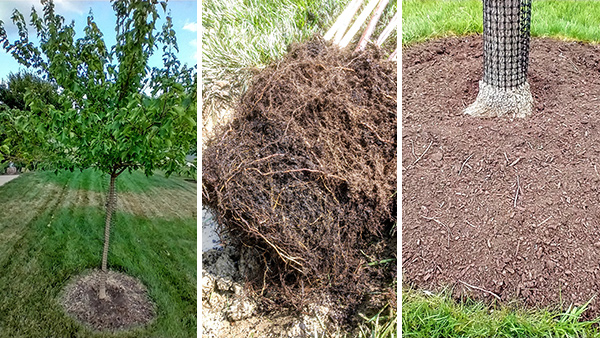
You’ve probably heard the old saying that the best time to plant a tree is 20 years ago, and the second best time is now. If you’ve recently been inspired to add a new tree to your landscape, there are a few steps you can take to get your new acquisition off to a great start.
Trees have very specific preferences in regard to planting depth. When a tree germinates in an undisturbed natural setting, it is generally able to establish a root system that spreads out near the soil’s surface, providing the growing tree with water, nutrients, and proper structural support. But all too often trees are planted too deeply in garden settings, compromising their health and structural integrity.

Whether a tree is grown in a pot or grown in a field to be balled and burlaped upon harvest, the root flare or buttress flare of the tree is commonly buried several inches or more below the soil surface. The root flare refers to the lower portion of the trunk where the first structural roots emerge from the tree. These first structural roots must be at the surface or a few inches below the natural grade of the soil. When the root flare is properly placed, the structural roots are able to provide ideal support for the aboveground portions of the tree, helping it to withstand wind and snow loads.

Roots also need to breathe and undergo gaseous exchanges to survive. Most of a tree’s root system develops within the top 18 inches of the soil, which is what allows these exchanges to occur. Most of the nutrients a tree needs for proper health are also found close to the soil’s surface. If roots are buried too deeply, a tree’s overall health will be greatly compromised.
To avoid these problems, our first line of defense is to purchase properly grown material. At the nursery or garden center, inspect prospective purchases to the best of your ability without damaging them. This can be done by gently digging at the base of the tree to see if you can feel or see the main structural roots at the soil’s surface or a few inches below the surface. As a consumer, you have purchasing power that can be used to help bring light to this issue. If trees are buried too deeply, kindly let the supplier know that this is the reason you will not be purchasing them. But if you are looking for very specific plant material and there are not many options, you may need to purchase a tree that has been buried too deeply and perform root flare excavation upon planting.

Another common issue with container-grown trees is girdling or circling roots. This occurs when a tree has been kept in its growing container too long. The developing roots will eventually reach the edges of the container, where they have no other option but to circle around the edge of the pot. At planting time, these circling roots must either be trimmed away or teased out and positioned at a 90° angle from the trunk. If this doesn’t happen, the roots will continue to grow in a circular direction. Over time, as the diameter of the trunk grows, it will come in contact with these circular roots, which will eventually girdle or cut off the vascular system of the tree just below the bark layer. This creates a major structural defect, and in some cases will cause the the tree to die.
If you plant a tree at the proper depth and eliminate circling roots, it should be able to thrive for decades.
—Adam Glas is a garden supervisor and rosarian at the Scott Arboretum of Swarthmore College in Swarthmore, Pennsylvania.
New to planting trees? Check out this article from our Gardening Basics Project Guide: Planting Trees and Shrubs the Right Way
For extreme cases of circling roots, you may need to try a more extreme technique. Here’s where to begin: A Better Fix for Root-Bound Plants
Fine Gardening Recommended Products

Spearhead Shade Gardening Shovel with Steel-Reinforced Fiberglass Handle
Fine Gardening receives a commission for items purchased through links on this site, including Amazon Associates and other affiliate advertising programs.

Harper Super Steel 700-lb. Platform Hand Truck
Fine Gardening receives a commission for items purchased through links on this site, including Amazon Associates and other affiliate advertising programs.



















Comments
Log in or create an account to post a comment.
Sign up Log in